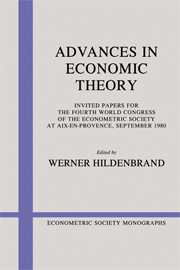Book contents
- Frontmatter
- Part I Economics of incentives
- Chapter 1 On theories of incentive compatible choice with compensation
- Chapter 2 The theory of incentives: an overview
- Part II Information and the market mechanism
- Part III Non-Walrasian economics
- Part IV Repeated games
- Part V Topics in competitive analysis
- Part VI Applied macroeconomics
- Part VI Industrial organization
Chapter 2 - The theory of incentives: an overview
from Part I - Economics of incentives
Published online by Cambridge University Press: 05 January 2013
- Frontmatter
- Part I Economics of incentives
- Chapter 1 On theories of incentive compatible choice with compensation
- Chapter 2 The theory of incentives: an overview
- Part II Information and the market mechanism
- Part III Non-Walrasian economics
- Part IV Repeated games
- Part V Topics in competitive analysis
- Part VI Applied macroeconomics
- Part VI Industrial organization
Summary
The theory of incentives is concerned with the problem that a planner (alternatively called a designer, principal, or government, depending on context) faces when his own objectives do not coincide with those of the members of society (whom we shall call agents). This lack of coincidence of goals distinguishes incentives theory from the theory of teams (Marschak and Radner, 1972), which postulates identical objectives, but which otherwise shares many features with our subject. In turn, the assumption that the planner, often the surrogate for society itself, has well-defined objectives separates incentives theory from most of social choice theory, which, since Arrow (1951), examines the possibility of deriving social objectives from those of individual preferences.
For an incentive problem to arise, noncoincidence of goals is not enough; the planner must care about either what agents know or what they do. That is, his objective function must depend either on agents' information or on their behavior.
An example of pure informational dependence is provided by the literature on resource allocation mechanisms. There, the planner's objective - social welfare - is a function of consumers' (agents') preferences and endowments. The incentive problem is, typically, that of eliciting this information.
Pure behavioral dependence is exhibited by an employee-employer relationship in which the employer is interested only in the employee's output. In this case, incentives pertain not to revealing what the employee knows but to inducing him to work hard. Of course, incentive problems typically involve both kinds of dependence.
- Type
- Chapter
- Information
- Advances in Economic Theory , pp. 31 - 94Publisher: Cambridge University PressPrint publication year: 1983
- 20
- Cited by

